Upgrade to Print Server 10.2
This section will describe the upgrade procedure of the Print Server when it is used in the following scenarios:
Print Server in the Standalone mode.
Print Server in the Site role in case of Central-Site configuration.
Using the Central-Site environment?
Always upgrade the Central Server first and the Site servers later. Backward compatibility between newer Central and older Sites is preserved. However, it is not possible to connect a newer version of the Site server to an older Central server.
See the manual for the Central Server upgrade first.
See other part of this document if you want to upgrade to a different installation or contact your support representative to get more information.
Upgrade Requirements
Before upgrading, verify that your server meets the hardware and software requirements and that the support license is valid.
Make sure that all the additional packages or applications which are used in the given installation environment are available and are compatible with the version you are about to install.
Software Requirements
Operating system:
Windows Server 2016 64-bit or higher (recommended).
Windows 8.1 64-bit or higher. Be aware of the connection limit of up to 20 clients.
Installation on a Desktop (non-Server) operating system like Windows 10 as well as a Domain Controller is not recommended.
To make sure that the system runs smoothly, you need to set an exception for both program and data folders in your antivirus settings.
.Net Runtime
Before the actual installation begins, the installation wizard will verify if required 3rd party components are installed on the server. If not, it will automatically download and install them. An Internet connection is required for this step.
Allow internet access to address http://redirect.myq.cz/* (* being a wild card) to allow download of these components.
You can also download and install all three required components manually:
.NET 8.0 Runtime which can be downloaded here.
Console apps
Desktop apps
Server apps
For Windows Server 2022 Core edition, it is necessary to install the Server Core App Compatibility Feature on Demand.
It can be installed from PowerShell as a Windows Update using this command: Add-WindowsCapability -Online -Name ServerCore.AppCompatibility~~~~0.0.1.0and then restarting the server.
Printer packages may require a higher version of the .NET Framework to be installed later.
Hardware Requirements
CPU: 4 cores - 8 cores
Memory: 6 GB RAM - 14 GB RAM
Disk: 10 GB plus additional storage for print/scan jobs, logs, history, and backups. The recommended size is at least 100 GB.
Use the higher requirements in case of:
Approaching the limit of supported terminals or parallel user sessions.
Using the job parser.
Using job archiving.
Using the Desktop client.
Using a lot of Office document printing via email/web/mobile.
Using watermarks.
Heavy usage of API.
We strongly recommend using an SSD hard drive for the installation of both the program and data parts of the application.
Support License Requirements
The required support license validity is 1 April 2023.
It is necessary to have a valid support license before proceeding with the upgrade. Without a valid support license, the upgrade process will not be permitted, or some parts of the system will not work after the upgrade.
You can check the validity of your support licenses in Settings > License.

If the support license is not valid at least until the required date, do not start the upgrade. Activate the new support license first to prolong the support validity and complete the upgrade afterward.
Minimum Version Requirements
The minimum version to upgrade from is 8.2.
If you are running an older version, please upgrade first to the latest available 8.2 release. Then proceed to upgrade to version 10.2.
If a site server has an invalid license—such as after restoring a backup to a new server but before obtaining a new license from the Central Server—you will see the following dialog:
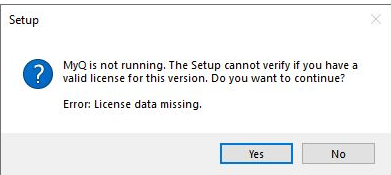
This is to be expected because the license is not valid. Click Yes to continue with the upgrade. The site server will request a new license from the Central Server after the upgrade and continue normal operation.
Free Space Requirements
During the upgrade process, both databases (containing data and logs) are upgraded and modified to be compatible with the new structure of the application. During this process, the HDD storage requirements grow significantly as the database contents are copied to temporary files while the database engine works on the required changes.
Space required during the upgrade process can be up to four times the size of the actual databases.
Verify that both the system hard drive (which is storing the temporary files) and the drive used for the data part of the application have at least four times the storage space available than the total size of both data and log databases.
The size of the databases can be found in the Data folder of MyQ. By default, this is C:\ProgramData\MyQ, or it can be found in the Easy Config application in Settings > Data folder.
Files are named MYQ.fdb and MYQLOG.fdb.

In this example, we can see that the total size of both databases is about 330 MB, so for the upgrade process, the C: drive must have at least 1,3 GB of free space.
If the data folder was on the D: drive, then the same amount of free space is also necessary there, because, by default, the temporary files are stored on the C: drive, and both drives must have sufficient storage available.
Having insufficient storage will lead to unexpected issues during the upgrade. Not only will the upgrade process most likely fail, but it may also present a threat to the whole operating system as all the available storage will be depleted.
Embedded Terminal and Client Compatibility
Embedded Terminals
Before starting the upgrade procedure, make sure that all the embedded or hardware terminal packages are compatible with the version you are upgrading to.
It is recommended to always use the latest available release of the terminal package.
Do not use lower terminal versions than those listed in the table below.
Do not use higher terminal versions than 10.2 – future releases will most likely not be compatible.
The use of an 8.2 or higher terminal version is required. Do not use Embedded terminal version 8.0 with Print Server 10.2.
From versions of Embedded Terminals 8.x the architecture of the terminal has been changed. These changes may affect the behavior of the Embedded terminal. When upgrading the Embedded terminal, please check the Support Bulletin which is part of the Partner portal for more information to find out if your brand requires extra steps.
Partner Portal -> Support -> Documentation -> Support Bulletin tab.
Currently, special steps are necessary for Kyocera Embedded terminal version 7.5. Please see the available Support Bulletin 04-2020 regarding the upgrade of the Kyocera Embedded terminal for more information.
If the currently installed terminal version is lower than the one listed in the table below, it is recommended to uninstall this terminal package before running the upgrade. Please, consult the corresponding terminal manual about the uninstallation procedure.
The following Embedded terminal packages are supported by Print Server 10.2:
Terminal | Supported versions | ||||
Canon | 10.2 | 10.1 | 8.2 |
|
|
Epson | 10.2 | 10.1 | 8.2 | 8.1 (EOL) |
|
HP | 10.2 | 10.1 | 8.2 | 8.1 (EOL) | 8.0 (EOL) |
Kyocera | 10.2 | 10.1 | 8.2 | 8.1 (EOL) |
|
Lexmark | 10.2 | 10.1 |
| 8.1 | 8.0 |
Ricoh | 10.2 | 10.1 | 8.2 |
|
|
Sharp | 10.2 | 10.1 |
| 8.1 |
|
Sharp Luna |
| 10.1 |
|
|
|
Toshiba |
|
| 8.2 | 8.1 (EOL) |
|
Xerox | 10.2 |
|
|
|
|
Please note that terminals marked with (EOL) are reaching End of Life and are not supported anymore. While still compatible and operational, their usage is not recommended or supported.
Compatibility of Other Applications
Before starting the upgrade procedure, make sure that all the additional software packages as well as any 3rd party applications are compatible with the version you are upgrading to.
The following applications are supported by Print Server 10.2.
Clients | Version |
Desktop Client | 8.2*, 10.0*, 10.2 |
OCR Server | 3.0, 3.0.1, 3.1 |
Mobile Print Agent | 1.3, 1.3.1 |
MyQ X Mobile Client | 10.1 |
Central Server | 10.2 |
Easy Cluster | N/A |
ScannerVision | 9.1+ |
*Versions can function with the MyQ X 10.2 servers primarily if used before upgrading to the 10.2 servers; use Desktop Client 10.2 for new 10.2 installations.
MyQ Desktop Client versions 8.2 and 10.1 are compatible only if used with the previous Print Server before the upgrade. In environments where MyQ Desktop Client was not used until this point, use version 10.2.
MyQ Mobile Printing application (Android or iOS) is not compatible with Print Server 10.2. Use MyQ X Mobile Client instead.
Easy Cluster was discontinued and is no longer available for Print Server 10.2.
It is recommended to always use the latest available release of the client software.
Do not use lower client software versions than listed in the table above
Do not use higher client software versions than 10.2 (not applicable to ScannerVision) – future releases will most likely not be compatible.
Customizations and Custom Reports
If any customizations are running in the current installation – be it customized reports, scripts, or anything else that is not included in the standard setup, contact MyQ support first to verify whether they are compatible with the version you are upgrading to.
Customizations are always created for a specific version, and they depend on its resources. These resources may not be present in the newer version and so the custom content may not work after the upgrade.
After finishing the upgrade, verify the MyQ Main Log to observe any errors and warnings, including those about incompatible customizations, and also test the customized functionality yourself.
Important changes in this release
Please note, that version 10.2 has major functional changes compared to previous versions, that will affect certain functions of the system.
See the list of changes and new features in Upgrade to MyQ X 10.2.
Please read this document carefully to understand the impact of such changes.
Backup
Before proceeding to the actual upgrade, do a backup first. This will ensure that in case of an unsuccessful upgrade process, there will be a backup set of data to return to.
It is recommended to physically copy the created backup files to a separate file storage.
Backup can be manually created either by using the MyQ web interface or Easy Config.
Web Interface
Login as *admin and in Settings > Scheduler run the backup tasks for:
Database and settings backup
Log backup
Check the log to see when the backup operations are finished.

Easy Config
Log in as a user with local administrator privileges on the server running MyQ and run the Easy Config application.
In the Database menu, open the Main database submenu and run the Backup command. The log database cannot be backed up using Easy Config.
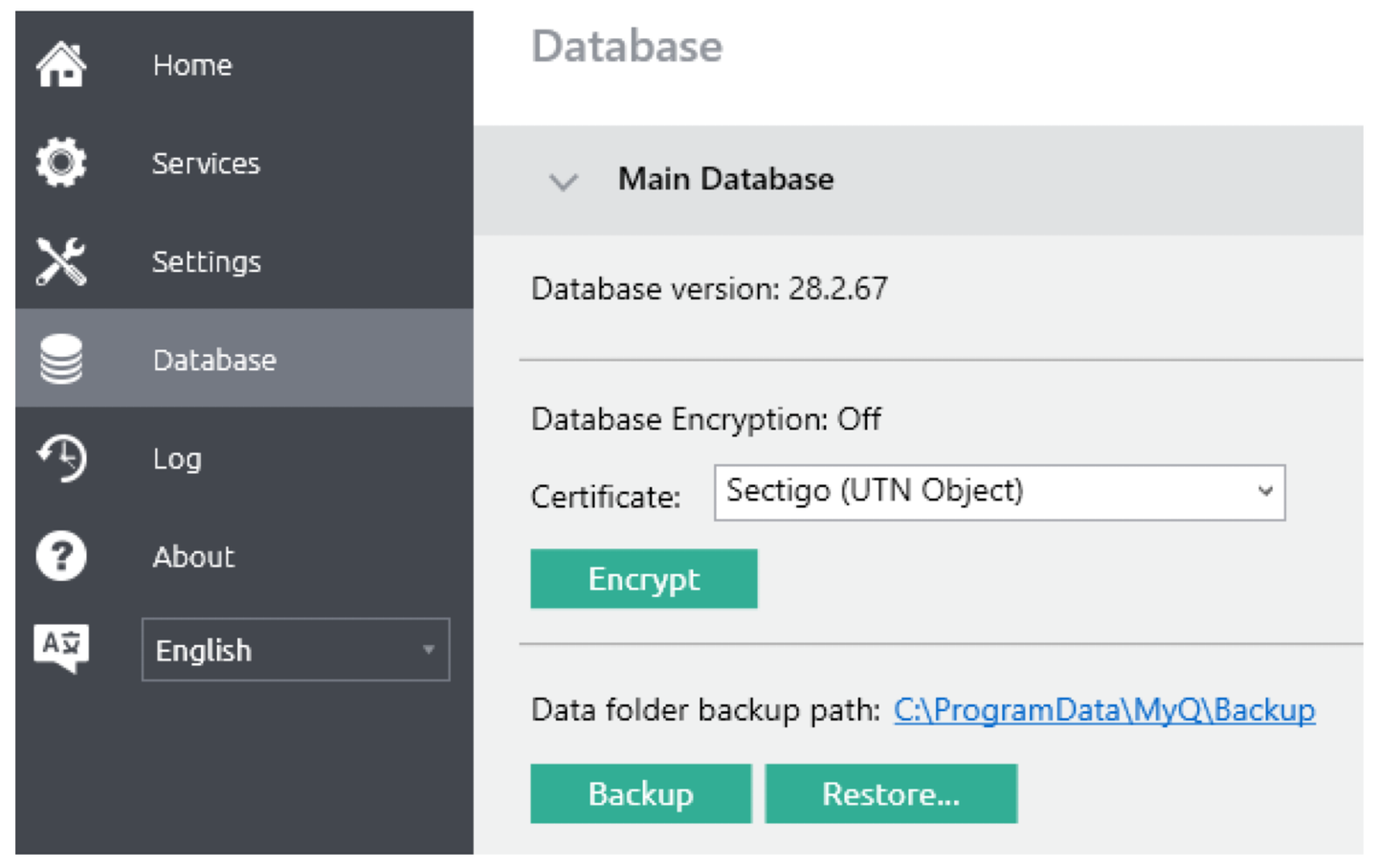
If you are running MyQ in a virtual environment, it is recommended to create a Snapshot/Checkpoint before upgrading. This will present the easiest way to rollback if required.
Upgrade Steps
Following the upgrade steps one by one in the correct order will ensure the most reliable outcome for the upgrade. Though the process itself is simple, it should still be considered critical, and the administrator should pay attention to every detail. Doing it right will minimize necessary downtime and help prevent unexpected issues.
Disable Scheduled Tasks
At the beginning of the upgrade process, it is best practice to disable all scheduled tasks. This is to avoid accidentally running a task that might require a lot of time to finish at a point that is not convenient. Also, if other components of the system are going to be upgraded (for example Central server and Site servers simultaneously), user synchronization and data replication might start when not desired.
In Settings > Task Scheduler, right-click all the tasks and click the Enabled button to disable the given tasks.
Some default tasks cannot be disabled, for those, it is recommended to check the next scheduled run time and alter it, if necessary.
Stop Services
The installation wizard will attempt to stop all application services so it may proceed with overwriting files and application components. It is best to do this step manually first and verify that all the services were stopped correctly and that there is no operation running in the background.
Until the services are stopped, and all running tasks complete, the files are blocked, and the installation wizard will not be able to overwrite them.
To manually stop services, use the Easy Config application and click on the Stop button in the Services tab.

Stopping all the services may take time as the services are not stopped immediately, instead, the system will wait for any running task to correctly finish. Do not force stop the processes using Task Manager as it may leave some tasks in a half-finished inconsistent state.
Stopping services will prevent users from using the system.
When services are stopped, it is possible to proceed with the following steps of the upgrade process. In this state it is ensured that no user is logged in and no task is running, so all the files and system components can be overwritten with an updated version.
After stopping all the services, manually run only the Database Server service. This service is necessary so the installation wizard can verify the version of the system, that is currently installed, and properly perform the upgrade, as well as run the database upgrade afterward.

At this point, it is the ideal time to create the database backup – because if such a backup must be restored, it will contain all the data since no one is using the system. This backup cannot be done via web UI since it is not currently running, it must be done via Easy Config.
Verify Nothing is Running
When services are stopped, verify all the processes are stopped using the Task Manager and the Details tab. Technically, some stuck processes may be still running and blocking the files, even though the related service is stopped.
In this state, only the two following processes should be running:
Firebird.exe
MyQ EasyConfig.exe
Make sure that there are none of the following processes or related services running:
CanonTerminal.exe
EpsonTerminal.exe
HPProTerminal.exe
HPTerminal.exe
httpd.exe
Kmum.Server.exe
LexmarkTerminal.exe
MyQ.exe
MyQKyoceraTerminal.exe
MyQSvc.exe
nssm.exe
php.exe
php-cgi.exe
rotatelogs.exe
SharpTerminal.exe
traefik.exe
XeroxTerminal.exe
If any of the previously listed processes is running, despite all the services being stopped, then it is most likely a stuck process and will block the correct execution of the upgrade installation wizard.
In such a case, it is recommended to restart the whole server. After restarting the server, go back to stop the proper services again and check for any running processes.
Upgrade
When it is verified that the system meets all the requirements, a backup is made all the services, and (except for the Database engine) all services are stopped and there are no running stuck processes that would block the installation wizard, we can proceed to the actual upgrade.
First, close the Easy Config application.
Make sure that the logged-in user has Local Administrator access rights and run the installation wizard.

Installation wizard file
First, choose the desired language of the installation wizard.
In the second step, you will be presented with a message that the previous version was detected, and an upgrade will be performed.
Continue through the license agreement to the Options steps.
Here, it is possible to choose from various options regarding the handling of different parts of the system. These options will vary in each version and will also depend on the version from which the upgrade is being made.
The dialogue step may look like this:
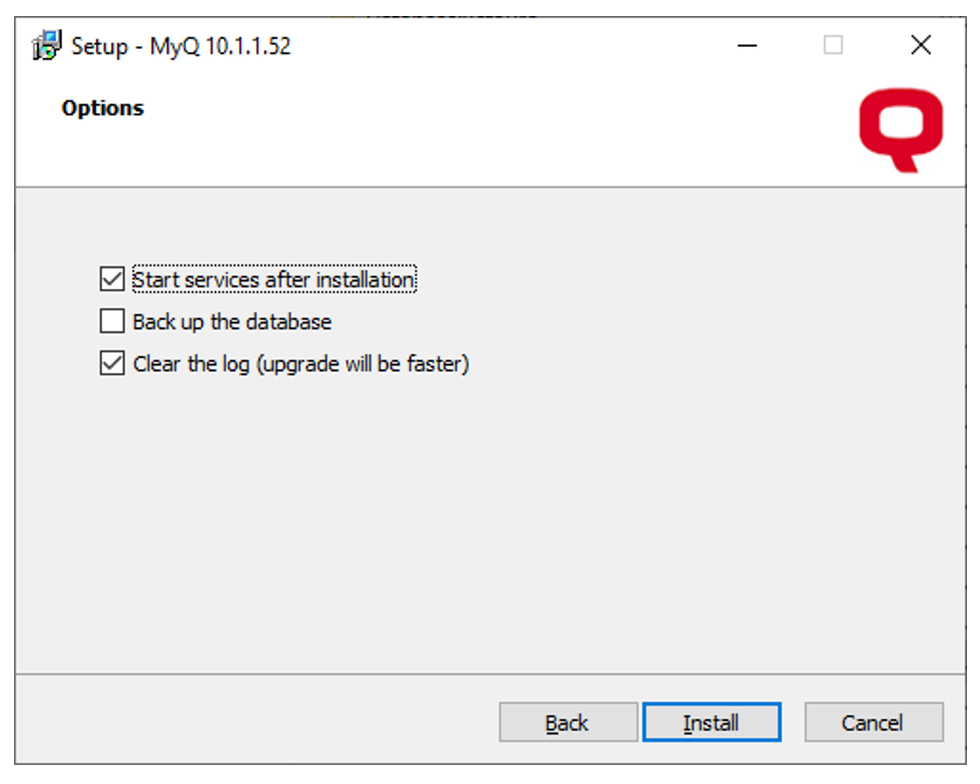
Backup of the database will create a standard backup as if run via Easy Config. This step is generally not required because the backup was done manually before starting the upgrade. In some cases, when the database engine is also upgraded, this option is forcibly enabled because the backup and then following restore are done to change the database engine version.
Clear the log option is generally recommended, since in most cases it is not necessary to keep the old log data. If the requirement appears for any reason in the future, there is a backup of the log database which can be used for this purpose. Deleting contents of the log database will free up some disk storage space and make the upgrade process faster.
The Start services after installation option is generally recommended. Only in case the previous upgrade was not successful for some reason, it is possible not to start the services right away and troubleshoot.
Continue with the Install button. After the installation wizard is finished, the Easy Config application will start.
You may be presented with a computer restart dialogue – in this case, make sure that Easy Config is not running, and it is not upgrading the database or doing other steps as a server restart will force stop this process and leave the database inoperable. If the Easy Config is not running, confirm the server restart. Do not skip the restart entirely, if prompted. After restart, the Easy Config application will automatically launch.
Easy Config will perform the database upgrade steps. This process will take some time, especially with larger databases. Some of the upgrade steps can take a lot of time – do not forcibly end this process.
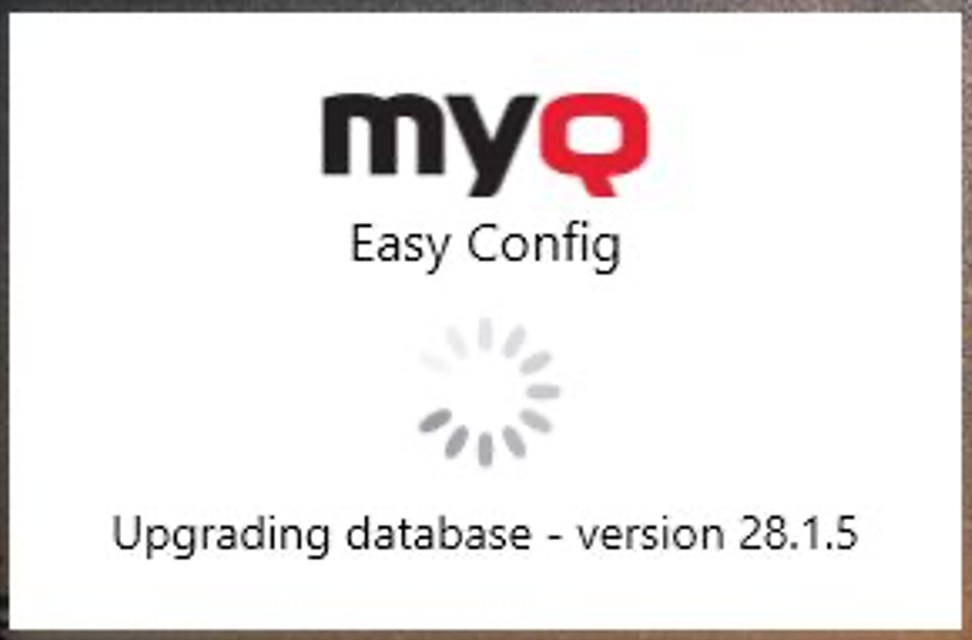
After the database upgrade is done, Easy Config will open on the Home tab where you can check basic details. It is recommended to go to the Services tab and verify that all the services are running. If not, click the Start All button.
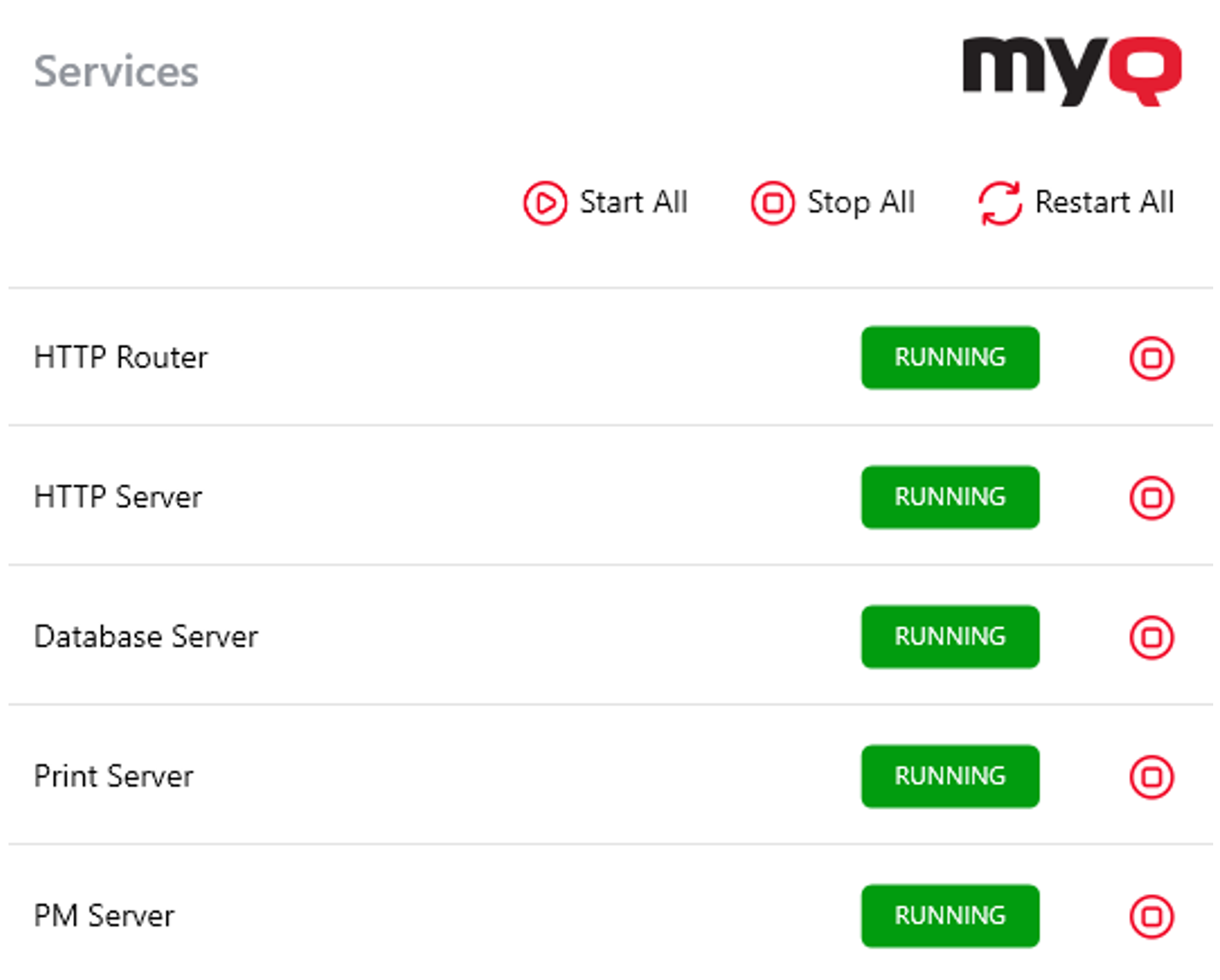
Then open the Database tab and submenus Main Database and Log Database – verify that the database status is OK for both the Main database and the Log database.

On the About tab, you can check the currently installed version to make sure that the upgrade was successful.
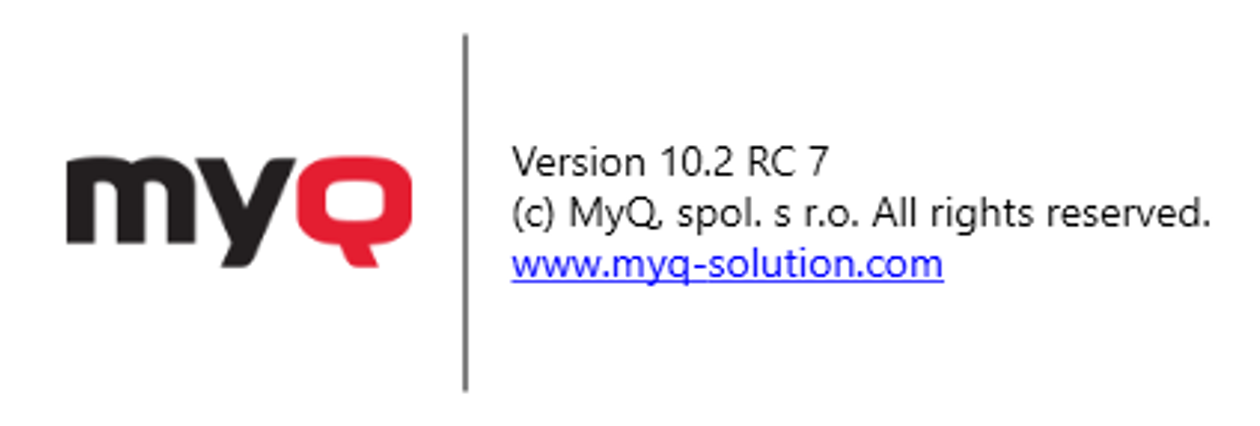
After this, proceed to the web interface, log in as *admin and verify that everything is running as it should, and re-install terminal packages if previously uninstalled.
We recommend checking the following areas, and whether they run correctly:
Log – for any error messages
Licenses
User synchronization
Site-Central connection and data replication
Scheduled reports generation
With all the previous steps finished, the upgrade is done. Congratulations!
.png)